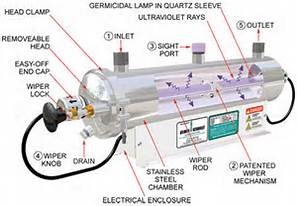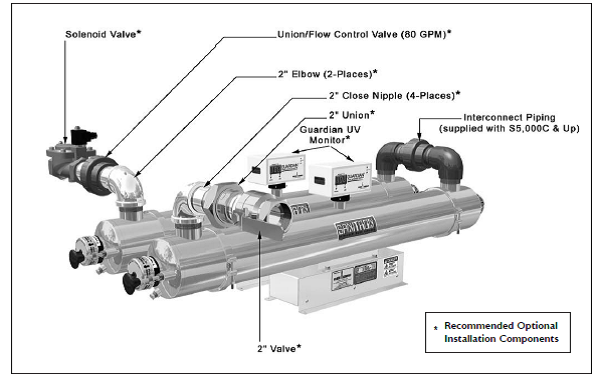UV Disinfection
UV disinfection is the secondary process that takes place in order to ensure that your system is properly treating collected rainwater. Just like rainwater filters, maintenance of these UV filters is extremely important. Read more below to understand UV filtration processes and procedures.
Disinfection Systems for Your Rainwater Harvesting System:
The most common disinfection process seen in rainwater harvesting systems is Ultraviolet Radiation technology. During this process, harmful micro-organisms that may remain in the rainwater after pre-filtration are destroyed by exposure to Ultraviolet light. Ultraviolet water purification filters are designed as an exceptional and rapid method of water disinfection without the use of heat or chemicals. UV filters utilize germicidal ultraviolet lamps that produce short wave radiation lethal to bacteria, viruses, and other micro-organisms occurring in rainwater. Most of these systems are designed as cylindrical housings with the light tubes located in the middle to maximize the exposure and detention time. The image below features a common UV lamp, housing, and major components.

Design and installation considerations for UV
Clean water is essential for UV disinfection and UV filtration happens after microfiltration. As discussed in our last blog, microfiltration down to 5 microns is the most effective precursor to UV disinfection. Microfiltration is so important because any floating particles that are not microbes will tend to “bounce” the UV rays and limit the effectiveness of the unit.
Individual units have limits to their effectiveness for any given flow rate and most are designed with a particular flow rate in mind. One of the more common sizes for rainwater systems is 40 GPM, so when designing a system, if you need more than 40 GPM, you will likely end up with 2 or 3 units. Most designs are controlled by the flow rate of the UV systems. Another consideration is the accessibility to the bulbs and the wipers. There needs to be enough room at the end of these units to allow for the wiper arm to be articulated and for the bulb to be removed for replacement. This is typically 50” of clearance space. Including an Ultraviolet Monitoring gauge in the design spec will alert the end user when maintenance is necessary.
Maintenance of UV systems
The effectiveness of UV systems relies on 3 factors
1. Cleanliness of the Incoming water (microfiltration)
2. Cleanliness of the bulb housing (wiper)
3. Strength of the light bulb
These systems house a gauge on the top that showcases the effectiveness of light penetrating the water. When this gauge falls below a certain point, the system is not working properly and it will sound an alarm or send a signal to building management. When this happens, the first step is to make sure that the pre-filters are filtering the water properly and are not clogged. The second step is to clean the lens by sliding the wiper back and forth. This lens collects film over time and needs to be cleaned regularly (weekly, monthly). Finally, about once a year (10,000 hours of use), the bulbs will need to be replaced.
What happens if something goes wrong?
Maintaining your disinfection system is critical to the effectiveness and design intent of a rainwater harvesting system. When the UV is not working properly, microbes are not being destroyed and there is a potential for bacteria, viruses, and other micro-organisms to pass through to your end use. Depending on the end use, this could be a major public health concern. In almost all cases, rainwater is not used as a potable resource, but any human interaction with this water could potentially be harmful. Other “nuisance issues” that non-disinfected water can cause are bad odors, films, buildup, discoloration, etc. An important thing to consider is most systems do not go into shut-down or bypass if the UV is in alarm. The water simply passes straight through. This is common for other disinfection systems as well, so that is why maintaining and monitoring this system is extremely critical.

Less common disinfection systems
While UV is the most common system in rainwater harvesting systems, sometimes other disinfection methods are utilized and, often, UV is used in tandem with these methods. Chlorine injection is a relatively common and time-tested method for disinfection. During this process, a chlorine solution is injected directly into the water stream. Some systems rely only on chlorine injection.
Ozone disinfection is another system that is sometimes seen in more critical applications such as cooling tower makeup water. This will provide a very high level of disinfection and completely removes targeted microbes like legionella. The drawback of Ozone is that it is highly corrosive to most typical rainwater components (including the cistern), so it needs to be used sparingly and the levels need to be well controlled.
Neglect of rainwater systems is normally where Tanks Direct sees high maintenance and replacement costs. If your system is showing any kind of visual alarm, or you feel like it is not operating properly, please contact our experienced Service and Maintenance Division.